Submitted:
23 January 2023
Posted:
25 January 2023
You are already at the latest version
Abstract
Keywords:
1. Introduction
- To describe and analyze the hydrogeological phenomena induced by the Andalusian earthquake of 1884.
- To establish a hydro-geomechanical conceptual model of the Zafarraya Fault that explains and allows understanding of these hydrological alterations.
- To implement a hydro-geomechanical numerical model to simulate the conditions of the massif surrounding the main fault during the pre-seismic and co-seismic phases. The results obtained from this simulation allow us to understand and explain the features and effects of the 1884 major event.
- To perform both matching and validation of both models.
2. Materials and Methods
2.1. Methodology
- Description of the hydrological alterations due to the 1884 Andalusia earthquake according to historical surveys.
- Based on bibliographic background, the next stage seeks the setup of the geological and hydrogeological framework, and the seismotectonic characterization of the Zafarraya Fault surrounding area.
- Setup of a preliminary hydro-geomechanical conceptual model.
- The next stage involves the setup of a hydro-geomechanical 2D finite element plane-deformation model built on the conceptual one. Such a model accounts for the fully coupled phenomenon, i.e., the interplay among the fault friction, the existence of interstitial water in the pores, and a poro-viscoelastic medium. The ground is assumed homogeneous and isotropic, although it includes a heterogeneous initial stress field due to its tectonic history. The simulation considers the fault as a one-dimensional entity with a “slip-weakening” frictional response, i.e., its frictional resistance weakens when the relative slip between its edges is triggered [55]. Seismic rupture occurs when the acting tangential stresses reach the frictional resistance value at any part of the fault.
2.2. The Zafarraya Fault: Tectonic Context, Displacement and Recurrence Periods
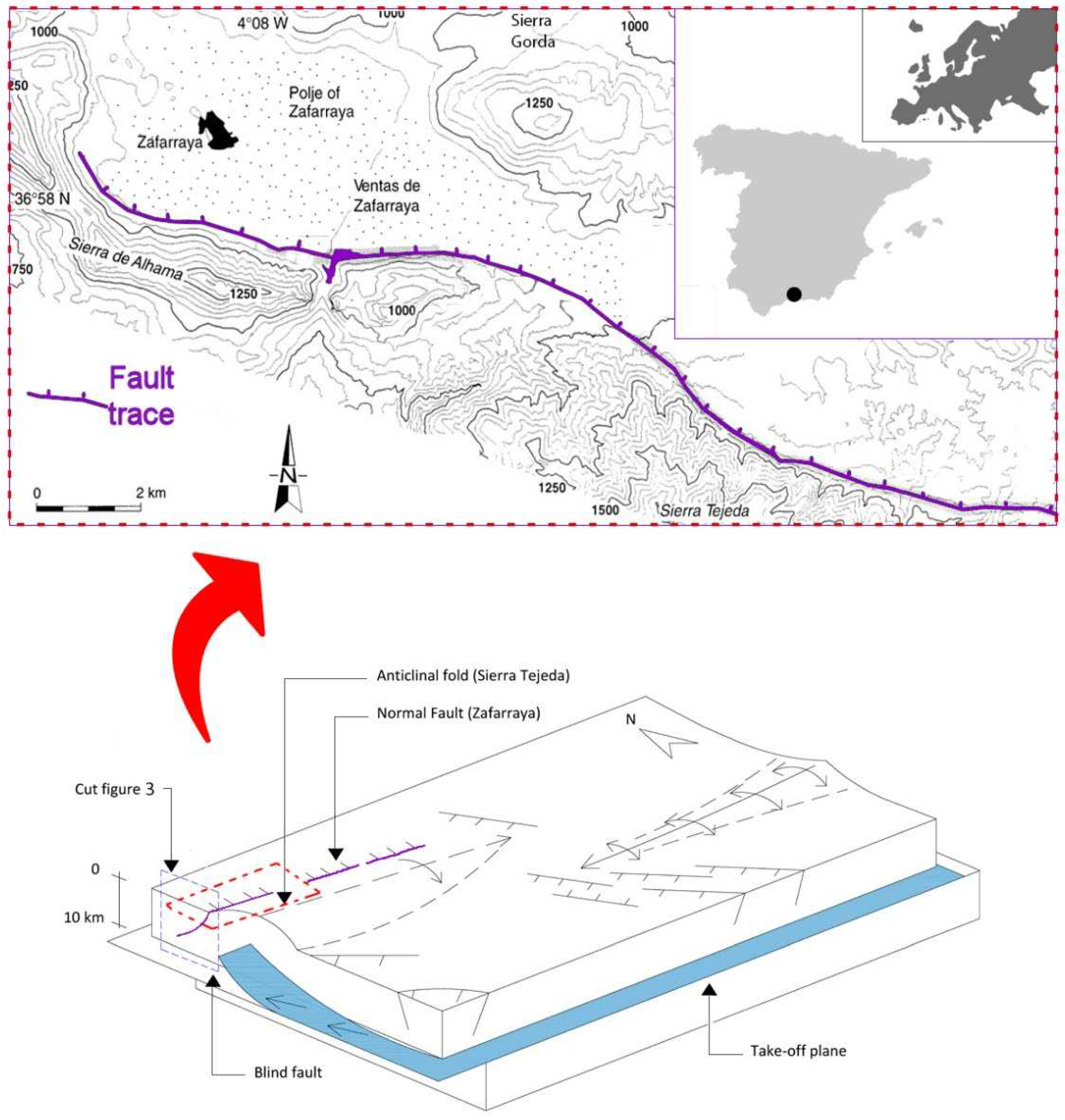
- Sierra Gorda Karstic Aquifer: it holds a free aquifer with Jurassic limestone and dolomite and a Keuper impermeable bottom. The carbonate formations are more than 1000 m thick. The average rainfall in the area is 840 mm. Its hydrogeological parameters are ; 𝑆=𝑚𝑒=1.5%.
- Polje of Zafarraya detrital aquifer: Made up of Miocene and Quaternary infill sediments from the basin, having a maximum thickness of 280 m. The upper Miocene and Quaternary sediments are about 60 m thick and include sandy and gravel alluvial deposits with clay intercalations. In general, this upper detrital aquifer feeds the limestone aquifer underneath, but sometimes the reverse happens due to heavy rains that flood the polje. The flow is directed mainly towards the NE, with a gradient of 0.085-1.7%. This aquifer is heavily exploited, with 400 wells, and the water table is shallow, less than 15m deep.
2.3. Hydrogeological Alterations: Types and Geographical Distribution
2.4. 2D Geological Model of the Fault
2.5. Coupled Physics Included in the Simulation Model
- is the fluid (water) density.
- is the constrained specific storage coefficient, which represents the volume of water either extracted from or added to storage in a confined aquifer per unit area of aquifer per unit decline or increase in the piezometric head. This unknown coefficient needs to be estimated through a model calibration. When the solid phase consists of a single constituent, the constrained specific storage becomes [66,67]:
- is the intrinsic permeability of the porous medium .
- is the dynamic viscosity of the fluid.
- is the Cauchy stress tensor.
- is the bulk rock density, , and the dry rock density.
- is the gravity acceleration vector.
3. Numerical Model Setup
3.1. The Fault Frictional Model
- is the shear resistance at any fault point.
- is the cohesion term of the resistance, neglected in this study.
- We include a radiation damping term that acts as a velocity-dependent cohesion, , in the definition of fault strength to resolve the rupture dynamics. Then we consider a damping factor , with being the shear wave speed. The phenomenon of radiation damping accounts for the volumetric dissipation mechanism of seismic waves, in the form of a velocity-dependent cohesion, in the definition of the friction resistance of the fault [65,69,70].
- is the friction coefficient of the contact.
- is the effective contact (normal) pressure at any fault contact point. It is given by , with being the contact pressure between the fault edges (compressive pressures are positive). Its value is chosen as the maximum on both sides of the fault, [71]. The fault remains locked when the shear stress acting on the fault, , is lower than the frictional strength, ; otherwise, it slips.
3.2. The Ground Model and Properties
3.3 The Finite Element Domain
4. Results and Discussion
5. Conclusions
Author Contributions
Funding
Data Availability Statement
Acknowledgments
Conflicts of Interest
References
- Quidam, U. (1885) Cartas desde los sitios azotados por los terremotos de Andalucía. Lib. Nac. y Ext. Madrid, 142. Available at: https://digibug.ugr.es/bitstream/handle/10481/7943/c-019-036%20%2837%29.pdf?sequence=1&isAllowed=y.
- Lasala y Collado, F. (1888). Memoria del comisario regio para la reedificación de los pueblos destruidos por los terremotos en las provincias de Granada y Málaga. M. Minuesa de los Ríos, Impresor, Madrid. Available at: http://www.bibliotecavirtualdeandalucia.es/catalogo/es/catalogo_imagenes/grupo.do?path=150661.
- Fouqué, F. (1889). Estudios referentes al terremoto de Andalucía ocurrido el 25 de diciembre de 1884 ya la constitución geológica del terreno conmovido, hecho por la comisión destinada al objeto por la Academia de Ciencias de París.
- Botella y Hornos, F. D. Los terremotos de Málaga y Granada. Bol. Soc. Geográfica de Madrid, 1885, t. XVII, 30.
- Fernández de Castro, M.; Lasala, J.P.; Cortázar, D.; Tarín, J.G. (1885). Terremotos de Andalucía. Informe de la Comisión nombrada para su estudio dando cuenta del estado de los trabajos en 7 de marzo de 1885. Available at: http://hdl.handle.net/10481/19269.
- Taramelli, T., Mercalli, G. “I terremotti andalusi cominciati il 25 diciembre 1884”. Atti Reale Accademia dei Lincei (Roma), 1886, vol. III, serie 4, 116-222.
- Seco de Lucena, L. (1941): Crónicas sobre el terremoto de Andalucía de 1884. Memorias. 79-103.
- Mercalli, G., and T. Taramelli (1885). Relazione sulle osservationi fatte durante un viaggio nelle regioni della Spagna colpìtte dagli ultimi terremoto, Nota preliminare Rendiccione R. Accademia dei Lincei June 1885 (in Italian). 18 June.
- Macpherson, J. Observaciones sobre los terremotos de Andalucía, Anales Soc. Española de Historia Natural, 1885, XIV, 4–6.
- Wang, Chi-Yuen, and Michael Manga. "Temperature and Composition Changes." Earthquakes and Water. Springer, Berlin, Heidelberg, 2010. 97-115.
- Santillán, D., Sanz de Ojeda, A., Cueto-Felgueroso, L.; Mosquera, J. C. Sismicidad inducida en embalses. Una aproximación mediante un modelo conceptual. Hidrogeología: Retos y experiencias, UIMP, Madrid (Spain), 2018.
- Udías, A.; Buforn, E.; Mattesini, M. Contemporary Publications in Europe on the Spanish Earthquake of 1884. Seismol. Res. Lett. 2022, 93, 3489–3497. [Google Scholar] [CrossRef]
- Barbot, S.; Lapusta, N.; Avouac, J.-P. Under the Hood of the Earthquake Machine: Toward Predictive Modeling of the Seismic Cycle. Science, 2012, 336(6082), 707–710. [CrossRef]
- Biot, M.A. "Mechanics of deformation and acoustic propagation in porous media." Journal of applied physics, 1962, 33(4), 1482-1498. [CrossRef]
- Rice, J. R.; Cleary, M. P. Some basic stress diffusion solutions for fluid-saturated elastic porous media with compressible constituents. Reviews of Geophysics, 1976, 14(2), 227-241. [CrossRef]
- Detournay, E.; Cheng, A.H.-D. Fundamentals of poroelasticity. Comprehensive rock engineering: Principles, practice and projects, J. A.Hudson, ed., Chap. 5, Pergamon, New York, 113–171, 1993.
- Ismail-Zadeh, A.; Soloviev, A. Numerical Modelling of Lithospheric Block-and-Fault Dynamics: What Did We Learn About Large Earthquake Occurrences and Their Frequency? Surv Geophys 2022, 43, 503–528. [Google Scholar] [CrossRef]
- Rundle, J.B.; Rundle, P.B.; Donnellan, A.; Li, P.; Klein, W.; Morein, G.; … Grant, L. Stress transfer in earthquakes, hazard estimation and ensemble forecasting: Inferences from numerical simulations. Tectonophysics, 2006, 413(1-2), 109-125. [CrossRef]
- Trifu, C.I., ed. The mechanism of induced seismicity. Birkhauser, Basel (Switzerland), 2002.
- Shapiro, S.A.; Rentsch, S.; Rothert, E. Fluid-induced seismicity: Theory, modeling, and applications. Journal of engineering mechanics, 2005, 131(9), 947-952. [CrossRef]
- Ellsworth, W.L. Injection-induced earthquakes. Science, 2013, 341, 1225942. [CrossRef]
- Deng, K.; Liu, Y.; Harrington, R.M. Poroelastic stress triggering of the December 2013 Crooked Lake, Alberta, induced seismicity sequence. Geophysical Research Letters, 2016, 43(16), 8482-8491. 20 December. [CrossRef]
- Cueto-Felgueroso, L.; Vila, C.; Santillán, D.; Mosquera, J.C. Numerical modeling of injection-induced earthquakes using laboratory-derived friction laws. Water Resources Research, 2018, 54. [CrossRef]
- Rutqvist, J.; Birkholzer, J.T.; Tsang, C.F. Coupled reservoir–geomechanical analysis of the potential for tensile and shear failure associated with CO2 injection in multilayered reservoir–caprock systems. Int. J. Rock Mech. Min. Sci. 2008, 45, 132–143. [Google Scholar] [CrossRef]
- White, J.; Foxall, W. Assessing induced seismicity risk at CO2 storage projects: Recent progress and remaining challenges. Int. J. Greenh. Gas Control 2016, 49, 413–424. [Google Scholar] [CrossRef]
- McGarr, A.; Barbour, A.J. Wastewater disposal and the earthquake sequences during 2016 near Fairview, Pawnee, and Cushing, Oklahoma. Geophysical Research Letters, 2017, 44(18), 9330-9336. [CrossRef]
- Catalli, F.; Rinaldi, A.; Gischig, V.; Nespoli, M.; Wiemer, S. The importance of earthquake interactions for injection-induced seismicity: Retrospective modeling of the Basel Enhanced Geothermal System. Geophys. Res. Lett. 2016, 43, 4992–4999. [Google Scholar] [CrossRef]
- Ellsworth, W.L.; Giardini, D.; Townend, J.; Ge, S.; Shimamoto, T. Triggering of the Pohang, Korea, earthquake (M w 5.5) by enhanced geothermal system stimulation. Seismological Research Letters, 2019, 90(5), 1844-1858. [CrossRef]
- Andrés, S.; Santillán, D.; Mosquera, J.C.; Cueto-Felgueroso, L. Hydraulic Stimulation of Geothermal Reservoirs: Numerical Simulation of Induced Seismicity and Thermal Decline. Water 2022, 14, 3697. [Google Scholar] [CrossRef]
- Segall, P.; Grasso, J. R.; Mossop, A. Poroelastic stressing and induced seismicity near the Lacq gas field, southwestern France. J. Geophys. Res. 1994, 99, 15423–15438. [Google Scholar] [CrossRef]
- Schultz, R.; Skoumal, R.J.; Brudzinski, M.R., Eaton, D.; Baptie, B.; Ellsworth, W. Hydraulic fracturing-induced seismicity. Reviews of Geophysics, 2020, 58(3), e2019RG000695. [CrossRef]
- Fernández-García, C.; Ruano, P. Caracterización de la geometría del Polje de Zafarraya a partir de prospección gravimétrica (Cordillera Bética). Geogaceta 2016. [Google Scholar]
- de Galdeano, C.S. The Zafarraya Polje (Betic Cordillera, Granada, Spain), a basin open by lateral displacement and bending. Journal of Geodynamics 2013, 64, 62–70. [Google Scholar] [CrossRef]
- López Chicano, M.; Pulido-Bosch, A. Síntesis hidrogeológica de los acuíferos de Sierra Gorda, Polje de Zafarraya y Hacho de Loja. Libro Homenaje a Manuel del Valle Cardenete. Aportaciones al conocimiento de los acuíferos andaluces. IGME, CHG, IAA (COPTJA), Diputación Provincial de Granada, Madrid, 2002, 311-340.
- Yolsal-Çevikbilen, S.; Taymaz, T. Earthquake source parameters along the Hellenic subduction zone and numerical simulations of historical tsunamis in the Eastern Mediterranean. Tectonophysics, 2012, 536: 61-100. [CrossRef]
- Andrés, S.; Santillán, D.; Mosquera, J.; Cueto-Felgueroso, L. Thermo-Poroelastic Analysis of Induced Seismicity at the Basel Enhanced Geothermal System. Sustainability 2019, 11, 6904. [Google Scholar] [CrossRef]
- Andrés, S.; Santillán, D.; Mosquera, J.; Cueto-Felgueroso, L. Delayed weakening and reactivation of rate-and-state faults driven by pressure changes due to fluid injection. J. Geophys. Res. Solid Earth 2019, 124, 11917–11937. [Google Scholar] [CrossRef]
- Pampillón, P.; Santillán, D.; Mosquera, J.C.; Cueto-Felgueroso, L. Dynamic and quasi-dynamic modeling of injection-induced earthquakes in poroelastic Media. Journal of Geophysical Research: Solid Earth 2018, 123. [Google Scholar] [CrossRef]
- Comisión del Mapa Geológico de España. «Estudios referentes al terremoto ocurrido en Andalucía el 25 de diciembre de 1884 y a la constitución geológica del suelo conmovido por las sacudidas, efectuados por la Comisión destinada al objeto por la Comisión de Ciencias de París». Bol. Com. Map. Geol. T. XXVI, 299-303, Madrid, 1890.
- Instituto Geográfico Nacional, El terremoto de Andalucía de 25 de diciembre de 1884, Ed IGN, Madrid, 1981. Available online: http://www.ign.es/web/resources/sismologia/publicaciones/Andalucia1884.pdf.
- Moro, M., Saroli, M., Stramondo, S., Bignami, C., Albano, M., Falcucci, E.; ... Wegmüller, U. New insights into earthquake precursors from InSAR. Scientific reports, 2017, 7(1), 1-11. [CrossRef]
- Chiaradonna, A.; Spadi, M.; Monaco, P.; Papasodaro, F.; Tallini, M. Seismic Soil Characterization to Estimate Site Effects Induced by Near-Fault Earthquakes: The Case Study of Pizzoli (Central Italy) during the Mw 6.7 2 February 1703, Earthquake. Geosciences 2022, 12, 2. [Google Scholar] [CrossRef]
- Kim, J.; Joun, W.-T.; Lee, S., Kaown, D.; Lee, K.-K. Hydrogeochemical evidence of earthquake-induced anomalies in response to the 2017 MW 5.5 Pohang earthquake in Korea. Geochemistry, Geophysics, Geosystems, 2020, 21, e2020GC009532. [CrossRef]
- Chang, K.W.; Yoon, H.; Kim, Y.; Lee, M.Y. Operational and geological controls of coupled poroelastic stressing and pore-pressure accumulation along faults: Induced earthquakes in Pohang, South Korea. Sci Rep 2020, 10, 2073. [Google Scholar] [CrossRef]
- Jung, Y.; Woo, JU.; Rhie, J. Enhanced hypocenter determination of the 2017 Pohang earthquake sequence, South Korea, using a 3-D velocity model. Geosci J 2022, 26, 499–511. [CrossRef]
- Kim, K.H.; Ree, J.H., Kim, Y.; Kim, S.; Kang, S.Y.; Seo, W. Assessing whether the 2017 Mw 5.4 Pohang earthquake in South Korea was an induced event. Science, 2018, 360(6392), 1007-1009. [CrossRef]
- McGarr, A.; Majer, E. L. The 2017 Pohang, South Korea, Mw 5.4 main shock was either natural or triggered, but not induced. Geothermics 2023, 107, 102612. [Google Scholar] [CrossRef]
- He, J.; Xia, W.; Lu, S.; Qian, H. Three-dimensional finite element modeling of stress evolution around the Xiaojiang fault system in the southeastern Tibetan plateau during the past~ 500 years. Tectonophysics, 2011, 507(1-4), 70-85. [CrossRef]
- Baptista, M.A.; Miranda, P.M.A., Miranda, J.M.; Victor, L.M. Rupture extent of the 1755 Lisbon earthquake inferred from numerical modeling of tsunami data. Physics and Chemistry of the Earth, 1996, 21(1-2), 65-70. [CrossRef]
- Mendes-Victor, L.; Oliveira, C.S.; Azevedo, J.; Ribeiro, A. (Eds.). The 1755 Lisbon earthquake: revisited (Vol. 7). Springer Science & Business Media, 2008.
- Oliveira, C.S. Lisbon earthquake scenarios: A review on uncertainties, from earthquake source to vulnerability modelling. Soil Dynamics and Earthquake Engineering, 2008, 28(10-11), 890-913. [CrossRef]
- Silva, P.G.; Elez, J.; Pérez-López, R.; Giner-Robles, J.L.; Gómez-Diego, P.V.; Roquero, E., ...; Bardají, T. The AD 1755 Lisbon Earthquake-Tsunami: Seismic source modelling from the analysis of ESI-07 environmental data. Quaternary International, 2021. [CrossRef]
- Lanza, F., Diehl, T., Deichmann, N., Kraft, T., Nussbaum, C., Schefer, S.; Wiemer, S. The Saint-Ursanne earthquakes of 2000 revisited: evidence for active shallow thrust-faulting in the Jura fold-and-thrust belt. Swiss Journal of Geosciences, 2022, 115(1), 1-24. [CrossRef]
- Orueta Duarte, D. Informes sobre los terremotos ocurridos en el sud de España en diciembre de 1884 y enero de 1885. Tip. y Lit. de Fausto Muñoz, 51, Madrid, 1885.
- Bizzarri, A. How to promote earthquake ruptures: Different nucleation strategies in a dynamic model with slip-weakening friction. Bulletin of the Seismological Society of America, 2010, 100(3), 923-940. [CrossRef]
- Srivastava, S. P., Schouten, H., Roest, W. R., Klitgord, K.D., Kovacs, L. C., Verhoef, J., Macnab, R. Iberian plate kinematics: a jumping plate boundary between Eurasia and Africa. Nature, 1990, 344(6268), 756-759. [CrossRef]
- Galindo-Zaldívar, J., Gil, A. J., Borque, M. J., González-Lodeiro, F., Jabaloy, A., Marín-Lechado, C., ... Sanz de Galdeano, C. Desarrollo simultáneo reciente de pliegues y fallas en las Cordilleras Béticas: la Falla de Zafarraya y el Pliegue de Sierra Tejeda. Geo-Temas, 2004, 6, 147-150.
- Reicherter, K. R., Jabaloy, A., Galindo-Zaldívar, J., Ruano, P., Becker-Heidmann, P., Morales, J., ... González-Lodeiro, F. Repeated palaeoseismic activity of the Ventas de Zafarraya fault (S Spain) and its relation with the 1884 Andalusian earthquake. International Journal of Earth Sciences, 2003, 92(6), 912-922. [CrossRef]
- Reicherter, K. R.; Peters, G. Neotectonic evolution of the central Betic Cordilleras (southern Spain). Tectonophysics, 2005, 405(1-4), 191-212. [CrossRef]
- Muñoz, D.; Udías, A. (1981). El Terremoto de Andalucía del 25 de diciembre de 1884. IGN. Available online: http://www.ign.es/web/resources/sismologia/publicaciones/Andalucia1884.pdf.
- López Chicano, M.; Pulido-Bosch, A. Síntesis hidrogeológica de los acuíferos de Sierra Gorda, Polje de Zafarraya y Hacho de Loja. Libro Homenaje a Manuel del Valle Cardenete. Aportaciones al conocimiento de los acuíferos andaluces. IGME, CHG, IAA (COPTJA), 2002, Diputación Provincial de Granada, Madrid, 311-340.
- López-Chicano, M. Contribución al conocimiento del sistema hidrogeológico kárstico de Sierra Gorda y su entorno (Granada y Málaga) (Doctoral dissertation, Universidad de Granada), 1993.
- López Arroyo, A., Martín Martín, A. J.; Mezcua Rodríguez, J. Terremoto de Andalucía. Influencia en sus efectos de las condiciones del terreno y del tipo de construcción. El terremoto de Andalucía de 1884, 1980, 5-94.
- Udías, A.; Muñoz, D. The Andalusian earthquake of 25 December 1884. Tectonophysics, 1979, 53(3-4), 291-299. 25 December. [CrossRef]
- Cueto-Felgueroso, L., Santillán, D.; Mosquera, J.C. Stick-slip dynamics of flow-induced seismicity on rate and state faults. Geophysical Research Letters, 2017, 44(9), 4098-4106. [CrossRef]
- Coussy, O. Poromechanics. John Wiley & Sons, London, 2004.
- Verruijt, A. Theory and problems of poroelasticity. 2013, Delft University of Technology, 71.
- Moczo, P.; Kristek, J.; Galis, M.; Pazak, P.; Balazovjech, M. The finite-difference and finite-element modeling of seismic wave propagation and earthquake motion. Acta Physica Slovaca, 2007, 57, 177–406. [CrossRef]
- Rice, J.R. Spatio-temporal complexity of slip on a fault, J. Geophys. Res., 1993, 98, 9885–9907. [CrossRef]
- Lapusta, N.; Rice. J.R. Nucleation and early seismic propagation of small and large events in a crustal earthquake model, J. Geophys. Res. 2003, 108, B42205. [CrossRef]
- Jha, B.; Juanes, R. Coupled multiphase flow and poromechanics: A computational model of pore pressure effects on fault slip and earthquake triggering. Water Resources Research, 2014, 50(5), 3776-3808. [CrossRef]
- Rudnicki, J.W; Rice, J.R. Effective normal stress alteration due to pore pressure changes induced by dynamic slip propagation on a plane between dissimilar materials. Journal of Geophysical Research: Solid Earth, 2006, 111(B10). [CrossRef]
- Dunham, E.M.; Rice, J.R. Earthquake slip between dissimilar poroelastic materials. Journal of Geophysical Research: Solid Earth, 2008, 113(B9). [CrossRef]
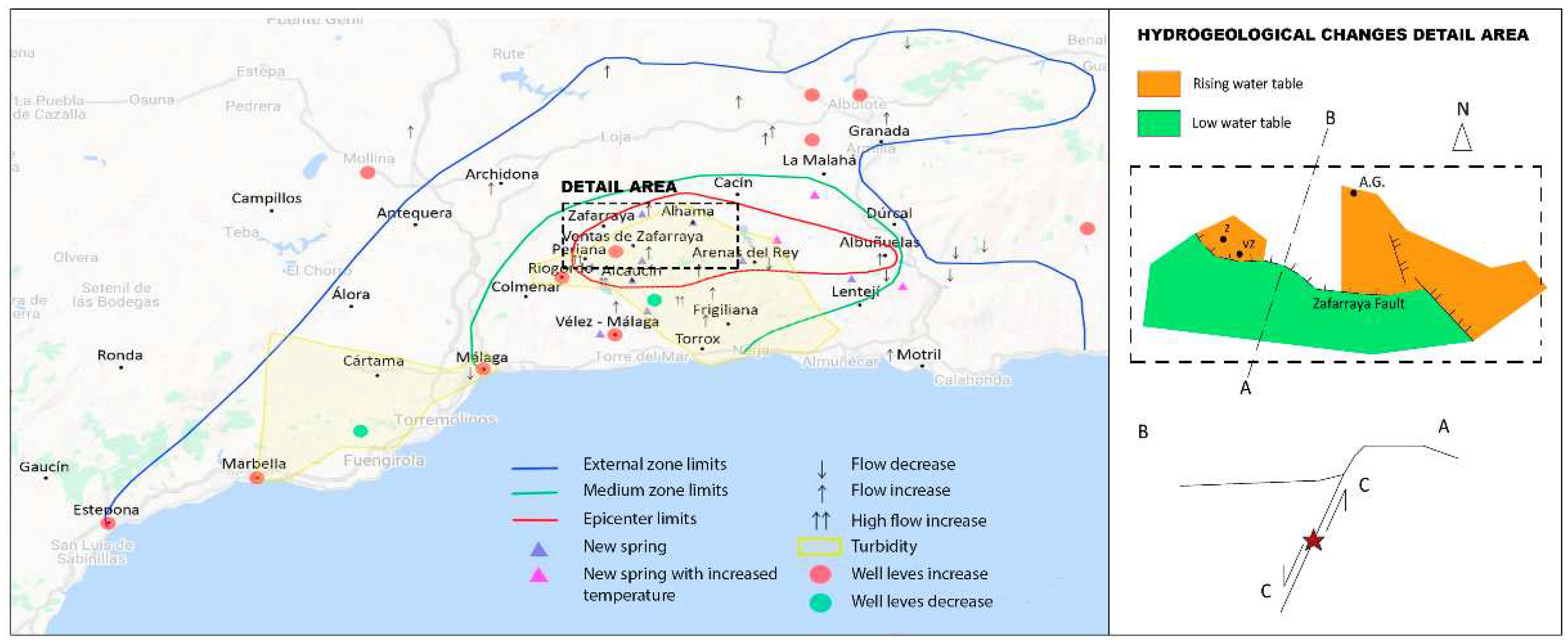
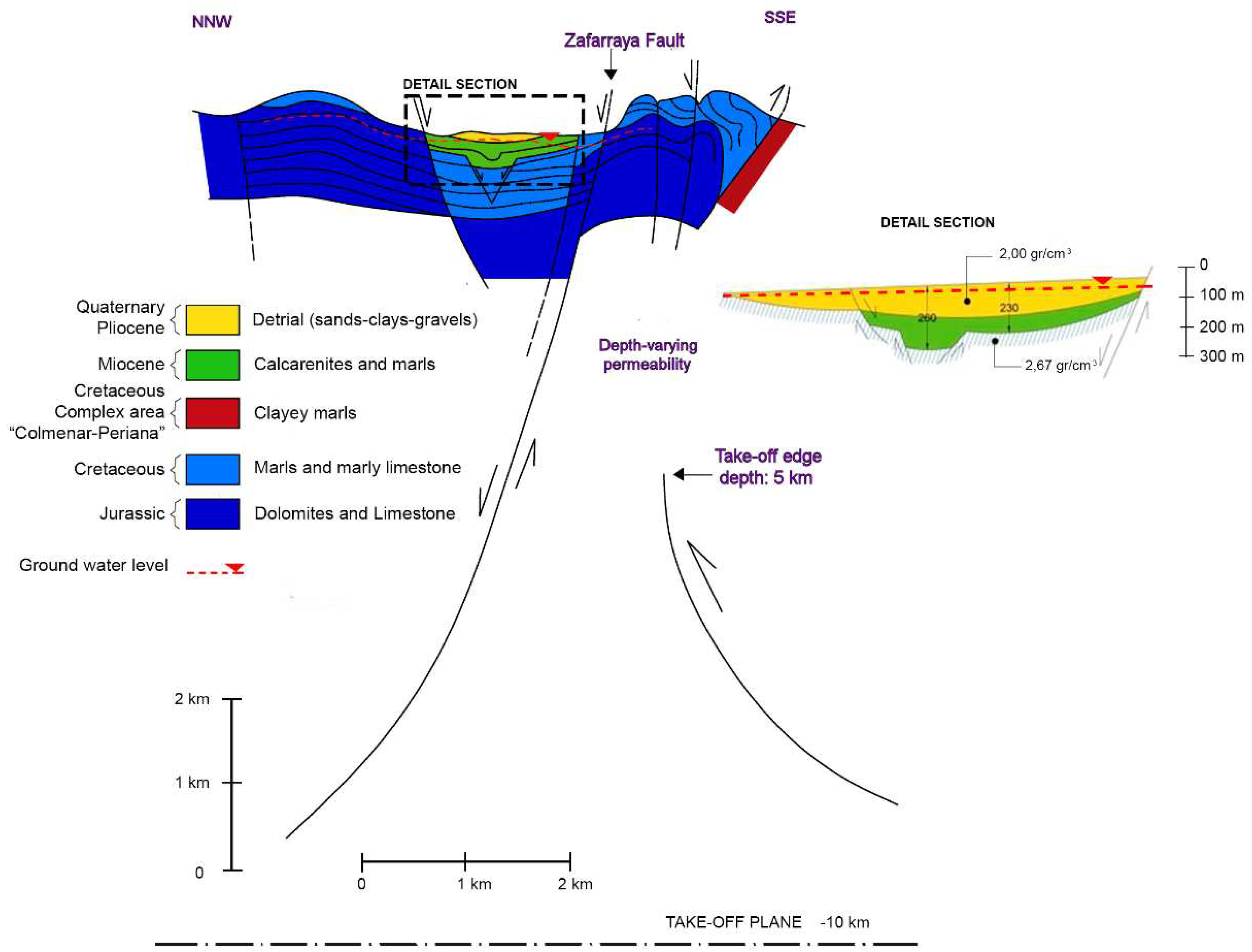
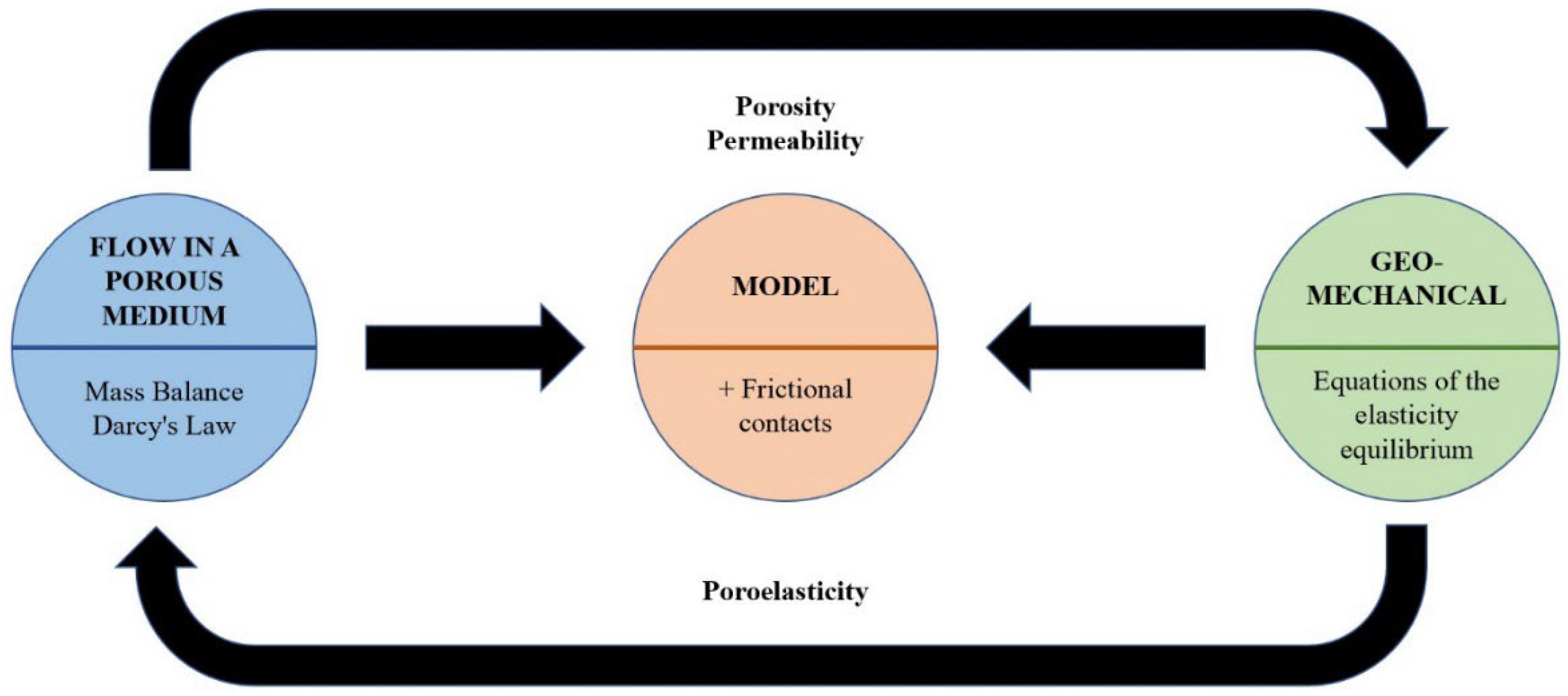
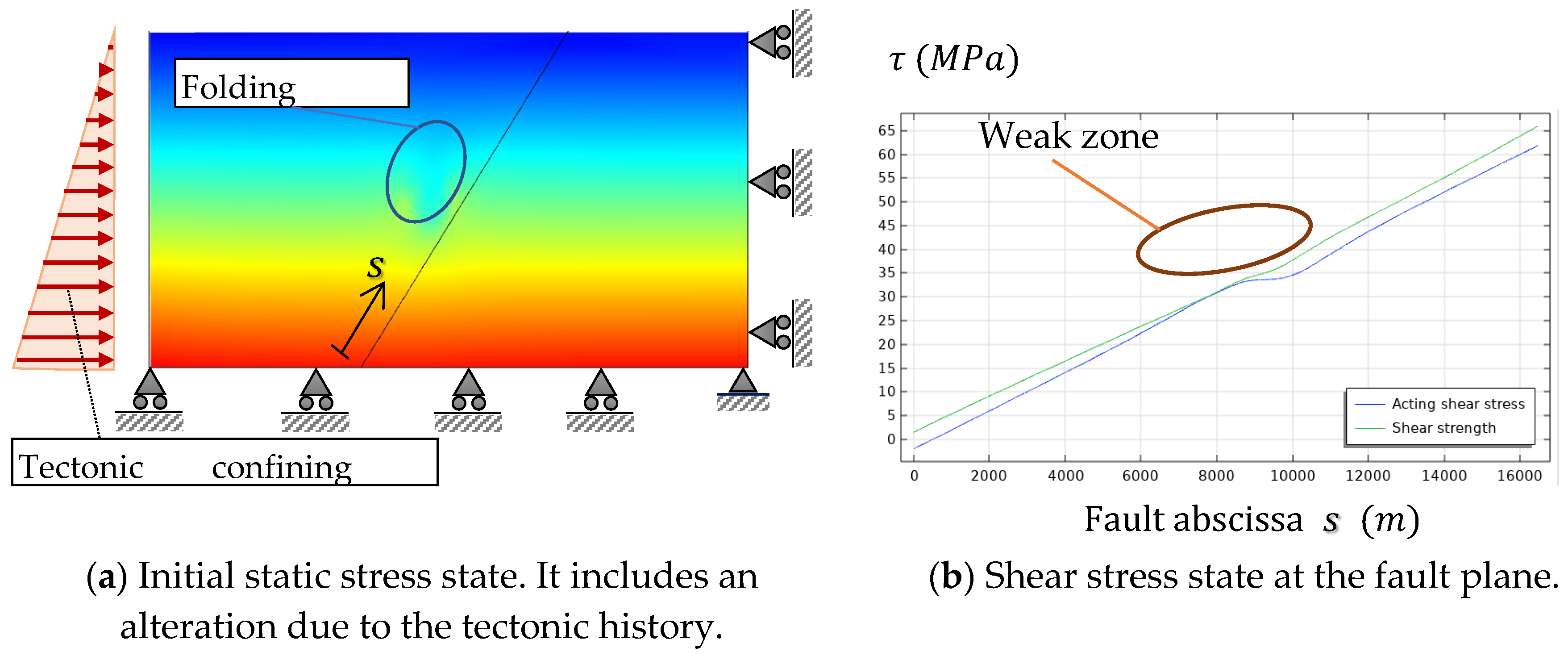
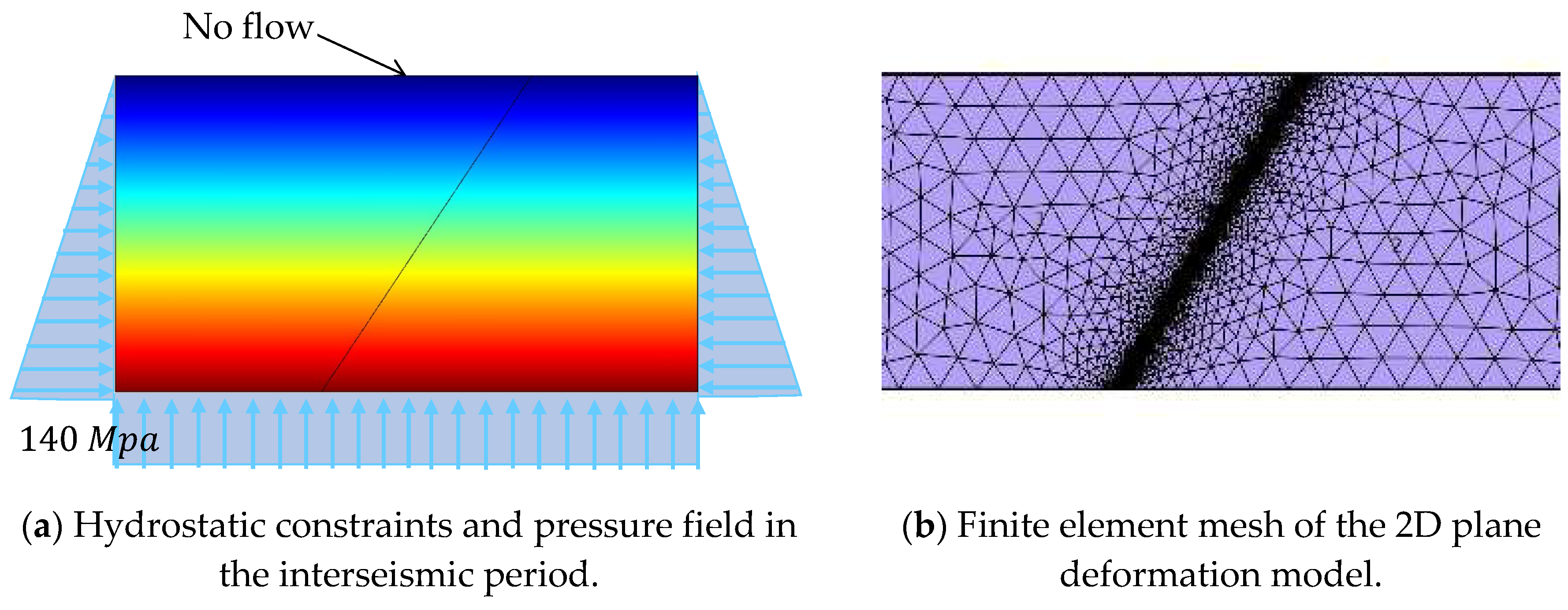
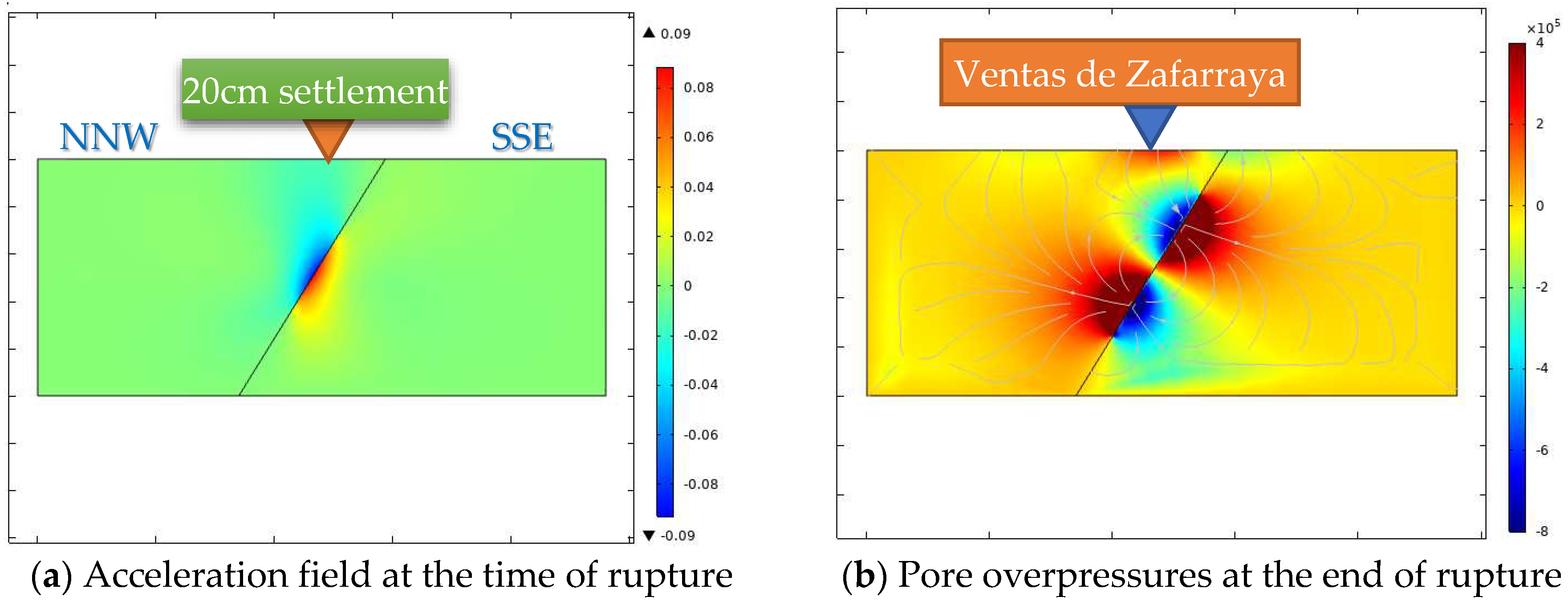
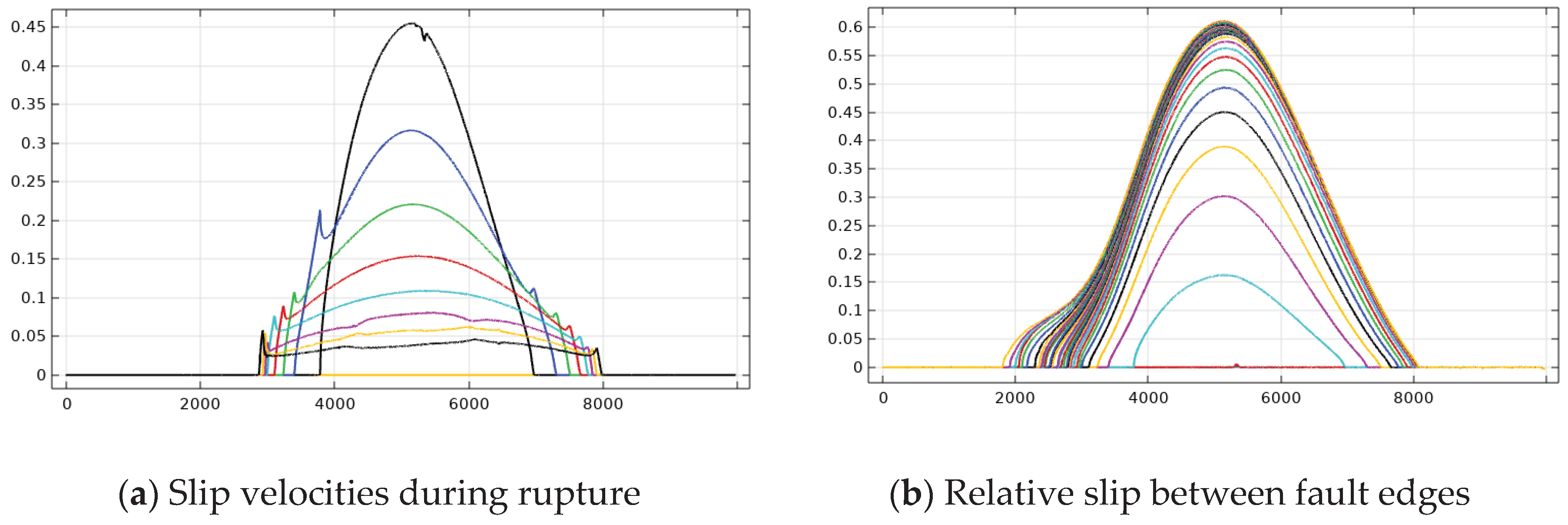
| Density (Ton/m3) |
(%) | Permeability (m/s) |
Depth of Water Table (m) |
|
|---|---|---|---|---|
| 1 | 2.00 | 13 | 1 m/day | <15 |
| 2 | 2.00 | 10 | 10-4-10-7 | - |
| 3 | 2.00 | 0.5 | 10-6 | - |
| 4 | - | 0.5 | - | - |
| 5 | 2.67 | 1.5 | 10-3-10-9 | - |
| 6 | 2.67 | 1.5 | 10-3-10-9 | - |
Disclaimer/Publisher’s Note: The statements, opinions and data contained in all publications are solely those of the individual author(s) and contributor(s) and not of MDPI and/or the editor(s). MDPI and/or the editor(s) disclaim responsibility for any injury to people or property resulting from any ideas, methods, instructions or products referred to in the content. |
© 2023 by the authors. Licensee MDPI, Basel, Switzerland. This article is an open access article distributed under the terms and conditions of the Creative Commons Attribution (CC BY) license (https://creativecommons.org/licenses/by/4.0/).





